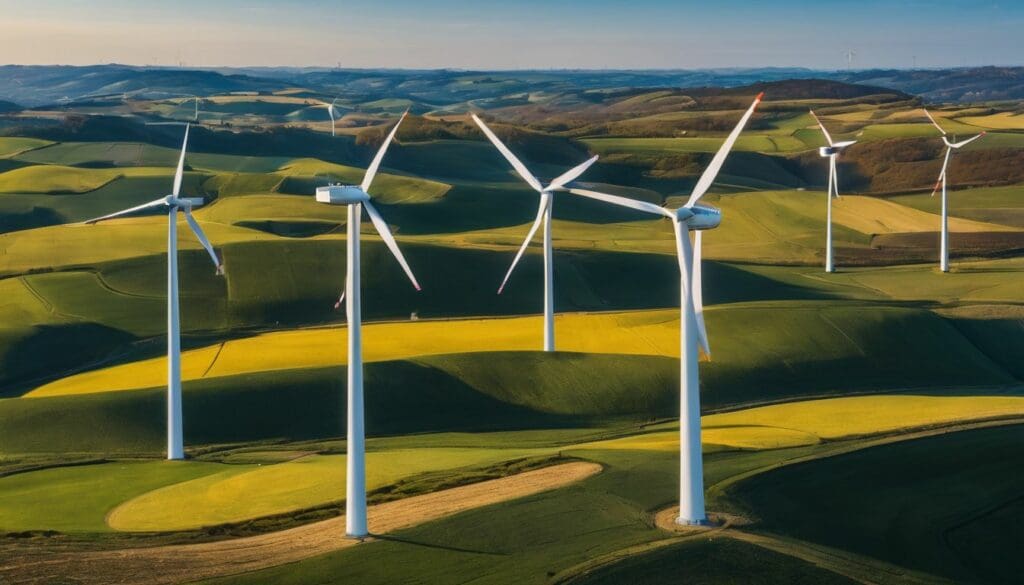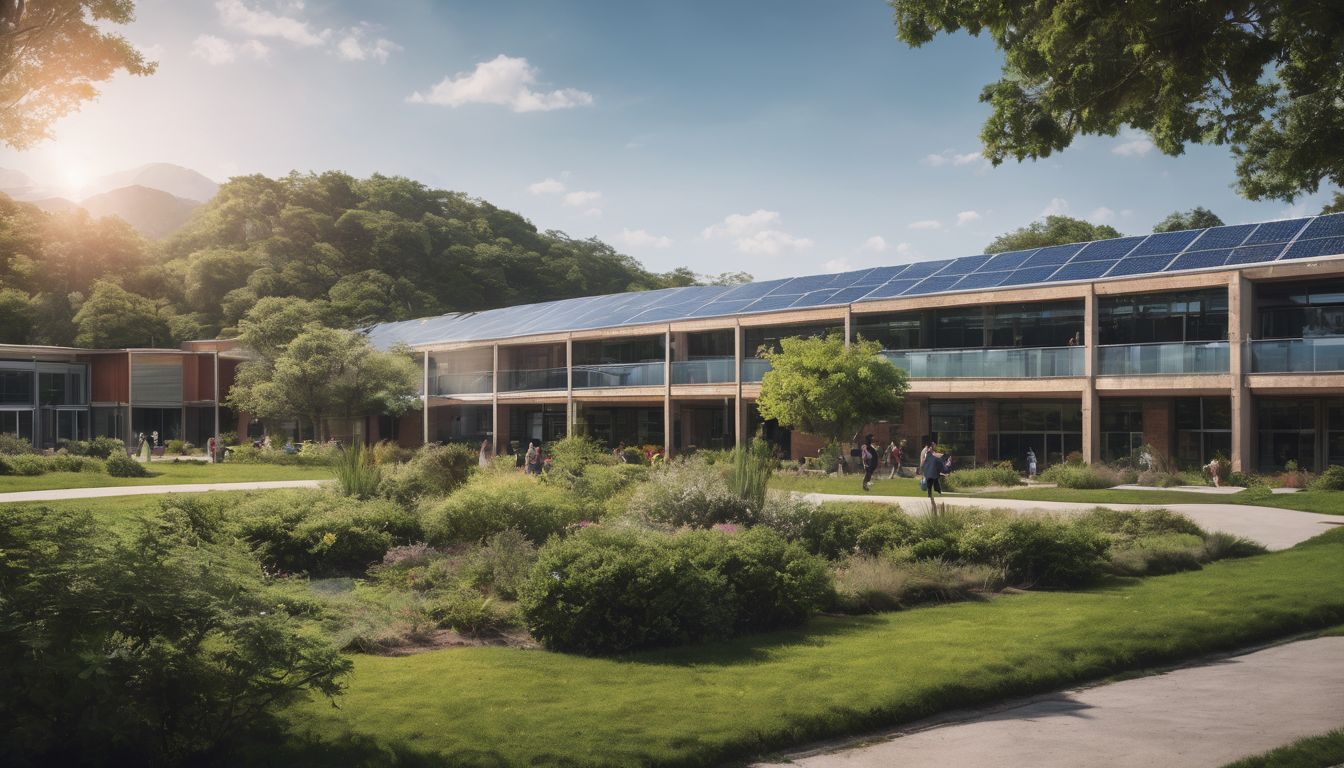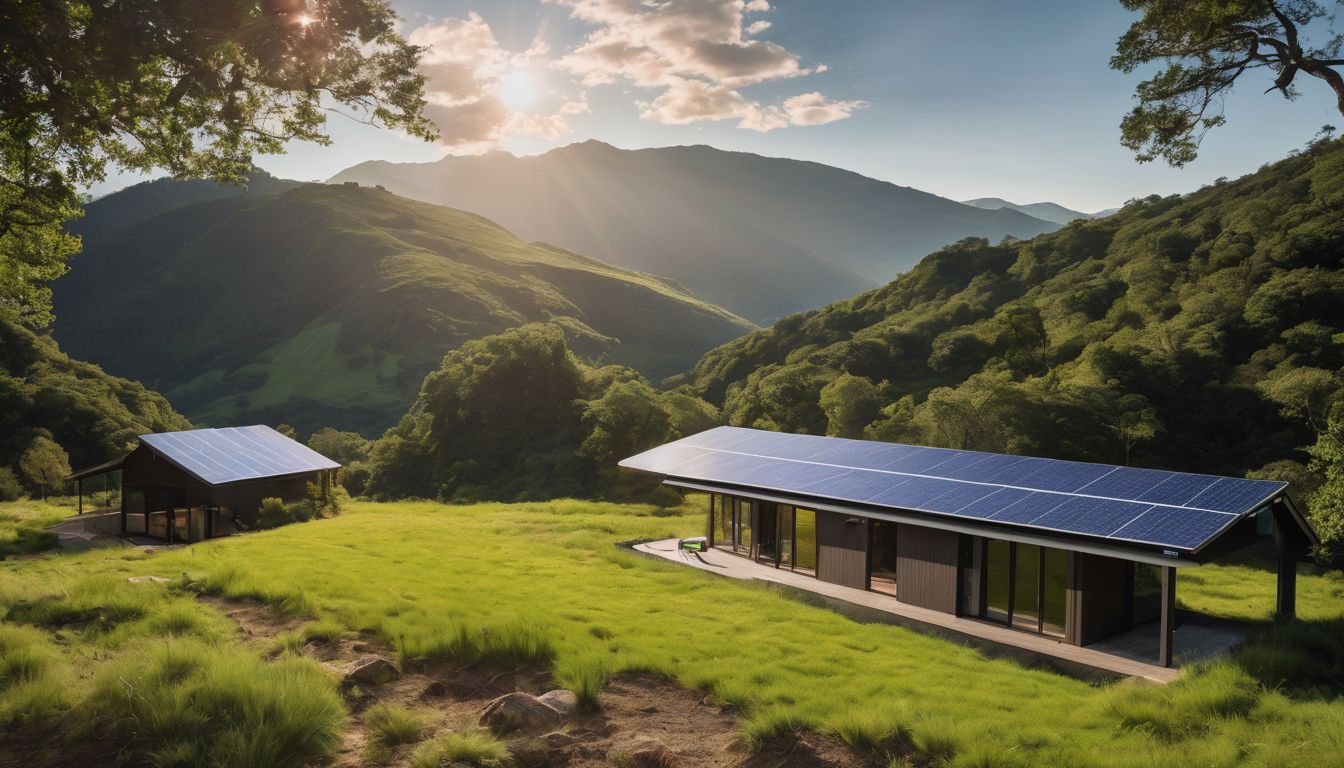Engaging young minds in the fight against climate change starts with education. Remarkably, by harnessing energy from the sun, wind, and other natural sources, we can power our world without depleting it.
This article is a treasure trove of tips and tricks for making renewable energy an exciting topic for kids. Dive in to spark a lifetime of eco-conscious living!
Key Takeaways
- Kids can learn about renewable energy sources such as solar, wind, hydro, geothermal and biomass through fun activities like building solar ovens or model wind turbines.
- Real – life experiences like visiting renewable energy facilities enhance understanding and interest in clean energy among children.
- Incorporating weekly themes for each type of renewable energy and organising engaging games helps maintain kids’ enthusiasm about clean and sustainable living practices.
What is Renewable Energy?
Renewable energy is energy that comes from sources that are naturally replenished, such as sunlight, wind, and water. It is sustainable and does not deplete natural resources.
Definition
Renewable energy comes from natural resources that can replenish themselves over short periods, unlike fossil fuels which take millions of years to form. Sunlight, wind, rain, tides, waves and geothermal heat act as endless sources of power.
These sustainable forms are crucial in fighting climate change as they produce energy without releasing harmful emissions into the atmosphere.
Harnessing these ecofriendly resources helps conserve our planet for future generations while providing clean energy alternatives. Next, we’ll explore why tapping into renewable energy is not just a choice but a necessity for sustaining our environment.
Why is Renewable Energy Important?
Renewable energy is important for sustainability and reducing environmental impact. Read on to learn more about teaching kids about renewable energy.
Sustainability
Sustainability encompasses the long-term use of clean, renewable energy sources to minimise our impact on the environment. It involves meeting our present needs without compromising future generations’ ability to meet their own.
Embracing sustainable practices can foster a healthier planet, reduce greenhouse gas emissions, and mitigate climate change. By incorporating renewable energy into everyday life, we can strive towards a more eco-friendly and balanced world where natural resources are preserved for generations to come.
Choosing sustainable energy options like solar power and wind energy is essential in reducing our reliance on conventional fuels that contribute to air pollution and global warming.
Reducing environmental impact
To reduce environmental impact, we can focus on using renewable energy sources. These clean energy alternatives help to minimise pollution and decrease our reliance on non-renewable resources.
By promoting the use of solar, wind, hydro, geothermal, and biomass energy, we can actively contribute to a greener future for our children.
Encouraging the adoption of renewable energy in households and communities is vital in preserving our planet for future generations. Making small changes like implementing solar panels or investing in wind turbines can significantly reduce carbon emissions and promote a more sustainable way of living.
Types of Renewable Energy
Learn about the various types of renewable energy sources and how they can benefit the environment. Read on to discover more about these eco-friendly options for powering our world.
Solar
Solar energy is a renewable energy source that harnesses the power of the sun to create electricity. Solar panels, made up of photovoltaic cells, capture sunlight and convert it into usable electricity.
This technology allows us to generate clean and sustainable energy without producing harmful emissions or depleting natural resources. Teaching kids about solar energy can involve fun activities like building solar ovens or conducting experiments with solar-powered toys, helping them understand the importance of harnessing this abundant and eco-friendly resource.
By exploring solar energy with children using interactive lessons and engaging activities, we can instill early awareness and appreciation for clean and sustainable power sources. Encouraging their curiosity about how solar panels work and involving them in projects where they can see firsthand how sunlight can be turned into usable energy helps develop a sense of responsibility towards the environment from an early age.
Wind
Wind energy is harnessed from the power of the wind. Wind turbines, like giant windmills, capture the energy and convert it into electricity. This process helps to reduce our reliance on non-renewable sources of energy and decreases harmful emissions that contribute to climate change.
Children can understand wind as a clean and sustainable source of power, creating opportunities for activities such as building model wind turbines or using pinwheels to demonstrate how the force of air can produce energy.
Involving children in discussions about renewable energies like wind power allows them to see first-hand how their actions can positively impact the environment. Teaching kids about harnessing wind energy encourages an early appreciation for sustainability while also nurturing a long-term commitment to preserving our planet’s resources.
Hydro
Hydro, or hydropower, harnesses the energy of flowing water to generate electricity. It is a renewable energy source that relies on the movement of water through turbines to produce power.
This process does not produce harmful emissions and is considered a sustainable way to meet energy needs. When teaching kids about hydro, it’s helpful to explain how dams or running water can be used to create clean energy, promoting an understanding of the importance of utilising natural resources for power generation.
Hydroelectric power plays a vital role in reducing carbon emissions and promoting environmental conservation. By introducing children to the concept of hydroenergy in engaging ways such as educational trips or hands-on experiments with water flow and mechanical devices, we can foster their interest in clean and sustainable sources of electricity from an early age.
Geothermal
Geothermal energy comes from the heat within the Earth. This renewable energy source uses hot water and steam to generate electricity. Kids can learn about geothermal energy through fun activities like creating a model volcano or visiting natural geysers and hot springs.
Exploring how this green energy works will help children understand its potential as a sustainable resource for the future.
Teaching children about geothermal energy encourages them to appreciate the Earth’s natural heat and explore eco-friendly alternatives to traditional power sources. With interactive lessons, kids can discover how harnessing underground heat benefits the environment while supporting clean, renewable energy initiatives.
Biomass
Biomass is organic material derived from plants and animals. It can be used to produce renewable energy through processes like combustion, gasification, and fermentation. This sustainable energy source includes wood, animal waste, agricultural crops, and food waste.
Biomass can be converted into biofuels such as ethanol and biodiesel, which are used in vehicles as cleaner alternatives to fossil fuels. Through teaching kids about biomass, they can learn about the importance of utilising natural resources responsibly and how these materials can contribute to a greener future.
Engaging children in understanding biomass involves interactive activities such as creating biodegradable crafts or exploring the possibilities of using food waste for composting at home or school.
How to Explain Renewable Energy to Kids
Engage kids in hands-on activities like building solar-powered models or conducting experiments to demonstrate the power of renewable energy, while also taking them on field trips to show real-life examples.
To learn more about teaching kids about renewable energy, keep reading our blog for interactive and educational ideas.
Use real-life examples
Teaching kids about renewable energy can be made much easier by using real-life examples. Here are some ways to bring it to life for them:
- Show them how sunlight powers solar panels and discuss the applications of solar energy in everyday life.
- Take them to a windy area, such as a beach or open field, and point out how wind turbines generate electricity.
- Visit a hydroelectric power plant to demonstrate how flowing water creates energy.
- Explore natural hot springs or geysers to explain how geothermal energy works.
- Discuss how organic waste can be converted into energy through biomass while composting at home.
Interactive learning activities
To keep kids engaged in learning about renewable energy, use interactive activities like:
- Building a solar oven to cook snacks using the sun’s heat, helping them understand how solar energy works.
- Conducting experiments with wind turbines made from household materials to demonstrate the power of wind energy.
- Creating a small hydroelectric generator to show how moving water can generate electricity.
- Visiting a geothermal power plant or natural hot spring to explore geothermal energy firsthand.
- Growing plants for biomass and then using them to make biofuel, teaching kids about the sources of biomass energy.
Field trips
To further enhance children’s understanding of renewable energy, taking them on field trips can provide valuable hands-on learning experiences. These interactive excursions offer a chance for kids to see sustainable energy sources in action and witness their impact on the environment. Here are some effective ways to incorporate field trips as part of renewable energy education for kids:
- Organise visits to solar farms and wind turbines to show children how these renewable energy sources work in real life.
- Arrange trips to hydroelectric power plants to demonstrate the generation of clean electricity from water.
- Plan visits to geothermal energy sites where kids can observe how heat from the Earth is harnessed for power production.
- Schedule visits to biomass facilities where children can learn about converting organic materials into energy.
- Coordinate eco – friendly nature walks that highlight the importance of preserving natural habitats and ecosystems.
DIY projects
Teaching Kids About Renewable Energy
Keeping Kids Interested in Clean Energy
To keep kids interested in clean energy, incorporating weekly themes, fun games and activities, setting a good example, encouraging further learning opportunities can help to maintain their engagement with renewable energy.
This will ensure they are enthusiastic about using and advocating for sustainable energy sources in the future.
Weekly themes
Teach kids about renewable energy through engaging weekly themes. Introduce different topics related to clean energy each week to keep their interest piqued. Here are some examples of weekly themes:
- Solar Power Week: Learn about harnessing the sun’s energy and its importance in reducing carbon footprint.
- Wind Energy Week: Explore how wind turbines generate electricity and their role in sustainability.
- Hydropower Week: Discover the power of water as a renewable energy source and its impact on the environment.
- Biomass Week: Understand how organic materials can be used to produce energy in an eco-friendly way.
- Geothermal Energy Week: Delve into the Earth’s heat and its potential for sustainable power generation.
Games and activities
Teaching kids about renewable energy can be fun and engaging through a variety of games and activities. Here are some ideas to keep children interested in clean energy:
- Renewable Energy Scavenger Hunt: Create a list of items or facts related to renewable energy, such as solar panels, wind turbines, or energy-saving tips, for kids to hunt for in the local area.
- Energy Bingo: Develop a bingo game with squares that feature different types of renewable energy sources like solar, wind, hydro, geothermal, and biomass.
- DIY Solar Cooker Project: Encourage kids to build their own solar cooker using simple materials and then cook a meal using only the sun’s energy.
- Renewable Energy Puzzles: Provide puzzles or crossword games that contain words related to renewable energy resources and technology.
- Eco-Friendly Science Experiments: Explore hands-on experiments that demonstrate the concepts of renewable energy, such as building small water wheels to learn about hydroelectric power.
- Sustainable Fashion Show: Host a fashion show where kids create outfits out of repurposed materials, promoting the idea of recycling and reducing waste as part of sustainable living.
- Environmental Charades: Play a game of charades with themes related to eco-friendly habits and renewable energy practices.
Setting a good example
While games and activities can be engaging, setting a good example is crucial in instilling the value of renewable energy in children. By incorporating green practices into daily life, such as recycling, conserving water and energy, and using eco-friendly products, adults can demonstrate to kids how to live sustainably.
Simple actions like turning off lights when leaving a room or choosing reusable items over single-use plastics can make a significant impact on young minds. Moreover, involving children in sustainable practices at home allows them to witness firsthand the positive effects of renewable energy and encourages them to adopt similar habits for the future.
Encouraging further learning opportunities
To encourage further learning opportunities, consider organising workshops or inviting experts to speak about renewable energy. Arrange interactive sessions and educational field trips to renewable energy facilities.
Utilise online resources, documentaries, and books tailored to children’s comprehension levels. Encourage hands-on learning through DIY projects that demonstrate the principles of sustainable energy.
Seek out local environmental organisations for additional educational programs and events related to renewable energy. Foster a culture of continuous learning by providing access to age-appropriate materials on green technology and clean energy sources.
Conclusion
Teaching kids about renewable energy is essential for shaping environmentally conscious and responsible individuals. By introducing them to the concept of clean, sustainable energy sources from an early age, we can instill in them a sense of responsibility towards conservation and environmental protection.
Engaging children in fun activities and interactive lessons on renewable energy not only educates them but also fosters their interest and passion for green living. As adults, it’s our duty to set a good example by incorporating eco-friendly practices into our daily lives, encouraging further learning opportunities, and nurturing their curiosity about renewable energy.
Encouraging children to explore renewable energy resources through engaging activities and real-life examples ensures they develop a deep understanding of the importance of using natural resources wisely.
FAQs
1. Why should we teach kids about renewable energy?
Teaching children about sustainable energy is vital for environmental education and helps encourage habits of energy conservation from a young age.
2. How can I engage my child in learning about green energy?
You can make learning about green energy fun by involving your child in activities that explore renewable resources or by using educational games focused on clean energy.
3. What are some fun activities to help kids understand renewable energy?
Fun activities for teaching renewable energy include building solar-powered models, watching engaging documentaries on eco-friendly innovations, and visiting wind farms or hydroelectric plants.
4. Are there specific resources available for students to learn about renewable sources?
Yes, there are numerous renewable energy resources for students including interactive websites, science kits, and curriculum-aligned textbooks specifically designed to educate kids on clean energy concepts.
5. At what age should I start introducing children to renewable energy sources?
It’s beneficial to introduce children to the concept of environmentally friendly power as soon as they begin exploring the world around them; even very young kids can grasp basic ideas of ecofriendly education through simple discussions and playful experiences.





